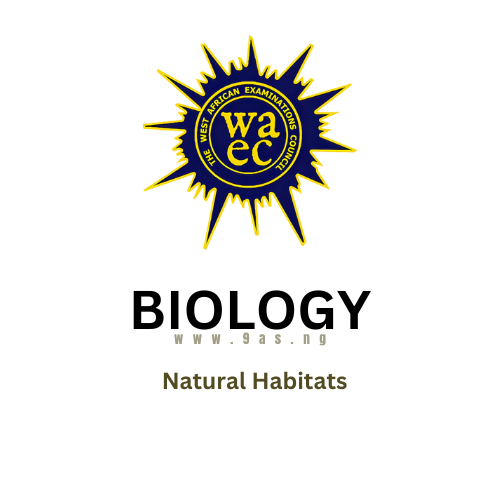OBJECTIVES
1. The major problem experienced by organisms living in small waterbodies is
A. drying up. B. oxygen deficiency. C. scarcity of food. D. wave action.
2. Which of the following features is not an adaptation of plants to aquatic habitat?
A. Breathing roots for entry of air. B. Flowers raised above water for the purpose of pollination. C. Spongy tissues containing gases for buoyancy. D. Hairy structures on the leaves to reduce water loss.
3. In which of the following habitats is paramecium found?
A. Pond. B. Aquarum. C. lake. D. Puddle.
4. The distribution of organisms in a fresh water habitat like a stream or pond is determined by the following factors except
A. light penetration. B. pH of the soil. C. rainfall. D. temperature.
Study the diagram of the zones of a marine habitat below and use it to answer questions 5 & 6

5. In which of the zones can very few organisms be found
A. I. B. II. C. III. D. IV.
6. Which of the following factors exerts a major effect on the distribution of living organisms in the habitat?
A. Salt. B. pH. C. Light. D. Rain fall.
7. Which of the following factors is the main problem facing xerophytic plants?
A. Competition for sunlight. B. Conservation of excess water. C. Inadequate roots for water absorption. D. Lack of adequate water.
8. What is the critical limiting factor for plants below the photic zone is an aquatic ecosystem?
A. Availability of nutrients. B. Availability of water. C. Intensity of light. D. Carbon dioxide concentration.
9. Which of the following is not an aquatic habitat?
A. Estuaries. B. Ponds. C. Rainforest. D. Swamp.
10. Which of the following factors is not associated with aquatic habitat
A. Temperature. B. Light intensity. C. Turbidity. D. Humidity.
11. Which of the following best describes a marine habitat? A large body of water
A. which has no distinctive colour or taste. B. with high concentration of salt. C. with little suspended materials. D. with no water weeds.
12. Puddles, ponds, rivers, lakes, seas and oceans are grouped together as
A. ecosystem. B. biosphere. C. terrestrial habitat. D. aquatic habitat.
13. Which of the following is not classified as a terrestrial habitat?
A. Forest. B. Guinea Savannah. C. Afro Alpine. D. Littoral zone.
14. Which of the following factors is not associated with aquatic habitats
A. Salinity. B. Turbidity. C. Temperature. D. Edaphic.
15. Terrestrial organisms which are capable of maintaining their body temperature constant within fairly close limits are referred to as
A. thermoclines. B. homotherms. C. poikilotherms. D. eurytherms.
16. Which of the following factors does not affect the distribution of organisms in an aquatic habitat?
A. Turbidity. B. Depth of water. C. Humidity. D. Temperature.
17. Plants found in the aquatic habitat are generally referred to as
A. epiphytes. B. halophytes. C. xerophytes. D. hydrophytes.
18. Siphons and gills are structures in aquatic organisms used for
A. gaseous exchange. B. buoyancy. C. excretion. D. movement.
19. Which of these factors are common to both aquatic and terrestrial habitats
A. Light, rainfall and turbidity. B. Light, temperature and tide. C. Light, rainfall and temperature. D. Rainfall, turbidity and salinity.
20. Which of the following environmental factors is not considered in a terrestrial habitat?
A. Temperature. B. Sunlight. C. Humidity. D. Turbidity.
21. The distribution of organisms in a fresh – water habitat like a stream or pond is determined by the following except
A. rainfall. B. temperature. C. pH of soil. D. light penetration.
22. Which of the following organisms can be found in fresh water habitat?
A. Sargassum and dog fish. B. Red mangrove and pond skater. C. Sargassum and red mangrove. D. Spirogyra and pond skater.
23. Which of the following factors may not affect living organisms in an aquatic habitat?
A. Turbidity. B. Temperature. C. Humidity. D. Light.
The table below shows the number of some organisms in habitats W and Y. Study it and answer questions 24 and 25.
| Organism | Number in the habitat habitat W | habitat Y |
| Plankton | 126 | 0 |
| Antelope | 0 | 51 |
| Water flea | 10 | 0 |
| Tilapia | 23 | 0 |
| Lion | 0 | 6 |
| Frog | 6 | 0 |
| Grass | 0 | 250 |
24. What type of habitat is W?
A. Rainforest B. Pond C. Desert D. Ocean.
25. Which of the following statements about habitat W is correct? The
A. Absence of lions and antelopes shows that the habitat is terrestrial. B. Presence of Tilapia and planktons shows that the habitat is not aquatic. C. Type of organisms present indicate that the habitat is aquatic. D. Absence of grasses indicates that the habitat is terrestrial.
26. The number of lions and antelopes in habitat Y shows that the lion
A. is the prey while the antelope is the predator. B. is the predator while the antelope is the prey. C. and the antelope are preys to each other. D. and the antelopes are predators.
27. Rabbits cannot survive in an aquatic habitat because they have
A. no scales. B. no gills. C. fore limbs. D. lateral line.
28. Which of the following features is a characteristic of aquatic plants? Possession of
A. multiple epidermis B. heavily lignified tissue C. finely divided leaves D. succulent stem.
THEORY
1. Name two examples each of plants and animals that live in a freshwater pond.
2. What is an Estuarine habitat?
3. What is a habitat?
4. (a) State four characteristics of a salt marsh habitat. (b) Explain briefly how plants are modified for anchorage in a salt marsh habitat.
5. (a) List three major zones in the marine habitat, stating one characteristic feature of each zone. (b)(i) Give one example each of plants and animals in the marine habitat (ii) Explain how each of the plants and animals is adapted to the habitat.
6. List three factors that affect organisms in the marine habitat.
7. (a) Name two abiotic factors each which affect plants and animals in a terrestrial habitat. (b) Describe the effects of three abiotic factors on a named plant and an animal in the habitat mentioned in (a) above.
8. List five abiotic factors which affect plants in freshwater habitat.
9. State four problems that organisms in the intertidal zone of a marine habitat could encounter.



